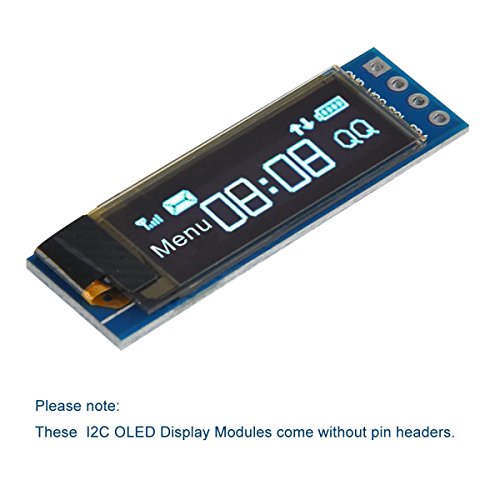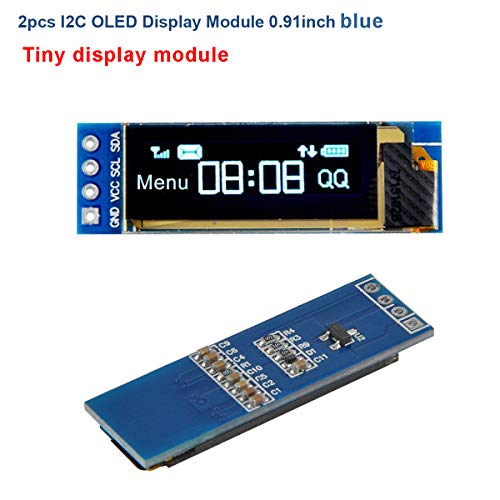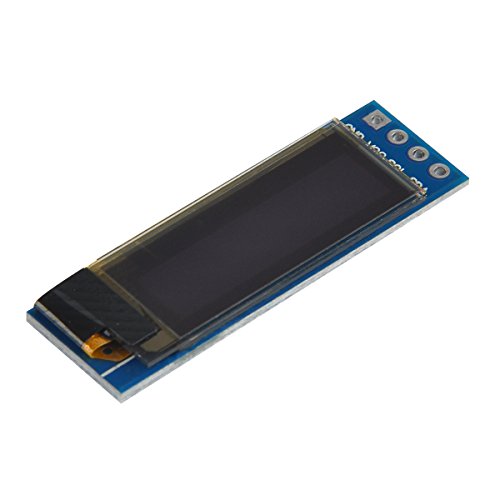- OLED display, no need backlight, self-illumination, Display Color: Blue. Plz note: These I2C OLED Display Module comes without pin headers.
- The display performance is better than the traditional LCD display, also lower consumption.
- IIC (I2C communications) simplifies connections.
- Use with Arduino, ESP8266, ESP32, STM32, etc; 3.35v Power; Operating temperature:-40 - 85 ℃; Resolution: 128 x 32.
- We a Strong After-sales Service Team: As long as you have any questions about the product, we will resolve your issue immediately if received your email, your satisfactory purchase experience is our greatest hope! How to email us? Plz click “MakerFocus” and click “Ask a question” to email us! Looking forward to your consultation!
-
Information
-
Twitter
-
Pinterest
-
Youtube
-
Facebook







Veronica Changed Brown
Bright, clean display for electronics projects
My first OLED to play with for Arduino. It took me a while to troubleshoot, but that's not the products fault! Library I had downloaded thought it was a 128x32, but I can confirm this was 128x64, as I got everything resolved. Used this to build the electronic d20 following the tutorial at MakeUseOf, and it looks great! Bright, crisp display.
Pinky Quiban
Works great for me and very visible
This review is for the "0.91 Inch White" - I bought the two pack and am using it for prototyping an arduino GPS speedometer type project. I'm using it with the Adafruit_SSD1306 library and their FreeMonoBold24pt7b font for numbers, fills the screen and looks great. My soldering skills are weak and when I tried to unsolders the headers that I put on one board so I would resolder on some wires I burned out the trace, but that's my fault. I bought another two pack, I really like these displays so far. I'm taking it to the track this weekend to test, will write back.
Maani Khan
Both work fine on a clone Nano
Update: these are x32 and I was running the x64 example sketch. they work fine. The vendor contacted me about my review and were eager to help, I will buy more from makerfocus. Old: I tried 4.7k pull-ups on clk & dat but nothing helped. I2C scanner sees them but the ssd1306_128x64_i2c example doesn't display anything. The program proceeds through its phases as if the boards are working, but they remain blank.
Debbie Holland
Bright and useful
These are fantastic! If you want to miniaturize your arduino projects grab one of these and an arduino nano. The display can run on 3.3v. It is legible, even with 4 lines of text. Highly recommended for projects that require some form of user interface. I will likely buy more in the future.
Malcolm King
Neat little display
These are nice little displays. I connected one to an Arduino UNO R3 and had it up and running the ADAfruit demo in around 10 minutes. The ADAfruit SSD1306_128_32_I2C was the library I used. Just Clone or download the zip and install the zip library. Connect the SCL and the SCA lines, power it with 5V and GND. Compile and upload the 128x32 I2C demo and voila it runs.
Generex Tabile
Really Wonderful little displays!
These things are tiny! That worked out well for me since the projects I was making were suppose to essentially stay out of the way if all went well. I used the Adafruit SSD 1306 Libraries and they worked great. They are low power and bright. For the adafruit library examles, they really are over the top. There is no "hello world" essentially, so just do a google search for a hello world example for the libraries to get a basic starting point. Also, to rotate the display 180 Degrees, put in display.setRotation(2); in the setup. Basic usage for those libraries are.. display.display(); display.clearDisplay(); display.setTextSize(1-3); display.setCursor(0,0); // origin of text display.print("blah"); display.println("-appended to last word blah, then new line"); As for the hardware, the displays are nice and small. If you think of your breadboard, they are 4 rows high, then about 12 slots wide. (That's the entire board.) Voltage range is impressive and seems to operate at lower than 3.3, but I'm running it on 4.5v and there are no problems. (Basically, 5v from the wall but through a diode on the arduino). It takes around 5ma. With a watch dog timer and adjustment I bet you could get a whole pro mini project to run at under 3ma standby while keeping the display going. Refresh time on the display is very fast and cameras don't pick up any multiplexing/flicker. They did not come with headers, but the plated through holes are very well done and take solder well. The holes are pretty snug, which means it's strong. It will be hard to desolder these after, so google some tricks on removing header pins to make your life easier! If this was a useful review to you, please give it a thumbs up! :D I think a lot of people had these questions..
Ruel Parala
Everything is as expected
Wired it up like the more expensive modules and was able to get it working with little effort. I am using it on an esp-01 to display messages from my MQTT server. I have lots of devices sending messages and want this to display a subset of the data that's coming through. I have gotten simple text to display and can draw lines on it but haven't scratched the surface of what it is truly capable of. One thing is that they are quite small.
Belan Martinez
These are almost same size as 0. 96 oled ...
These are almost same size as 0.96 oled but with connector cable and pins on side, they take small overall space. I replaced 0.96 oled with this one in small clock and weather project and it fit right in. These come without pin headers, I had pin headers some lying around and soldered them as soon as I got these. Pictures for reference.
Paul Hopp
Awesome little OLED display!
This is an awesome, tiny, high resolution OLED for any of your micro controller projects. It uses the very common I2C bus, and runs on the SSD1306 display driver. 128x32 pixels gives you a nice sharp, crisp text output. I'm very happy with these. This is a really good way to add a very compact LCD to your project. No need to add some big bulky backlit LCD, go with this instead!! I've bought a lot of different things from MakerFocus, and their products are always good. If you need to use this on ESP Easy firmware, please note you'll need to modify the plugin to include 128x32 size, as it doesnt have that yet, as of 2.2.0 dev-12. However, the patch to enable that size is out there and should be merged in the next release
Shqipe Llugiqi
Need moAr!
Great little display! I used to run an external display on my wife’s tomato boxes, but now I have all the info I need on the board.